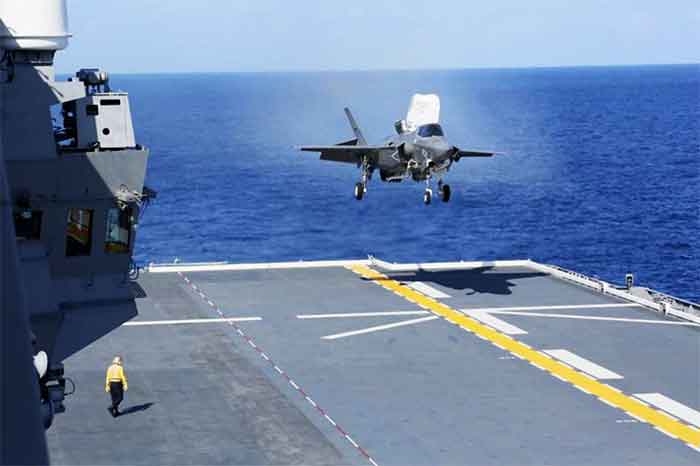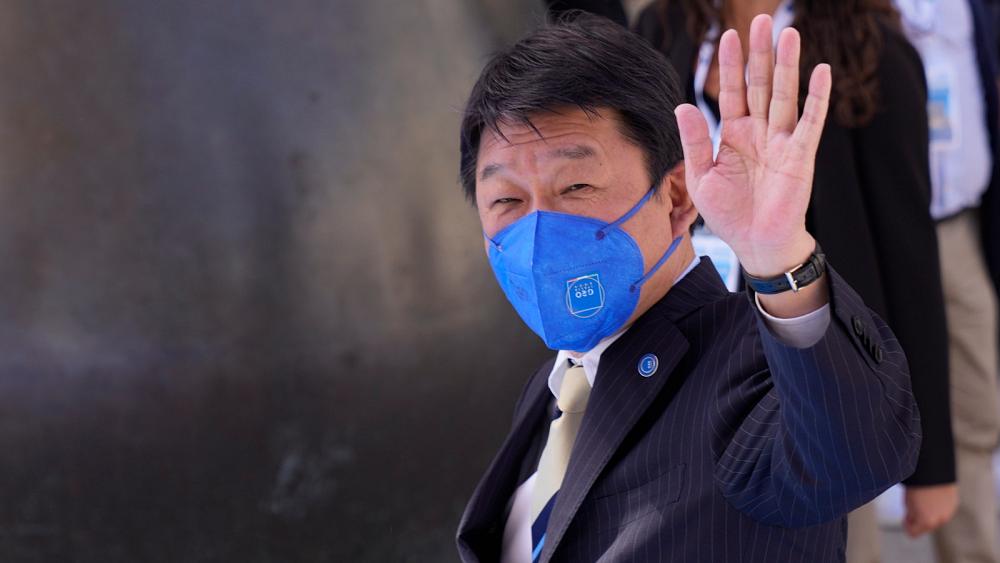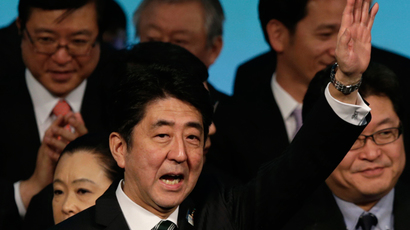
Although unfamiliar with the details, most people recognize the purpose of stealth technology is to make aircraft effectively immune to radar detection at normal combat ranges. The question is, would it be possible, employing the same technology, to make stealth aircraft carriers? The answer, even with Japan’s undoubted technical prowess, is a decided no, at least not for the foreseeable future.
If this is true, the question of Japanese stealth aircraft carriers would appear to be an oxymoron. But in Japan (as in many countries involving questions of war and peace), what you see (and hear) is definitely not what you get. For example, if you were to ask the average Japanese on the street about the particulars of Japan’s two aircraft carriers, you are likely to get an incredulous look, followed by, “What are you talking about? Japan doesn’t have any aircraft carriers!” At least technically speaking, that is true, for at present the Japan Maritime Self-Defense Force (Navy) has no category of ships bearing the title “aircraft carrier.”
Is it possible that Japan plans to build aircraft carriers in the future? Perhaps, but this misses the point that Japan already has not one but two aircraft carriers by the names of Japanese Ship (JS) Izumo and Kaga. Don’t the Japanese people know this?
The answer to this question begins in 1947 when Japan adopted, at American insistence if not provision, its first postwar constitution, including Article Nine that states: “Aspiring sincerely to an international peace based on justice and order, the Japanese people forever renounce war as a sovereign right of the nation and the threat or use of force as means of settling international disputes. In order to accomplish the aim of the preceding paragraph, land, sea, and air forces, as well as other war potential, will never be maintained. The right of belligerency of the state will not be recognized.”
In light of Article Nine, how could Japan possess two aircraft carriers or, for that matter, any military at all? The quick answer is, “by stealth.” The stealth began in August 1950 when, still under Allied Occupation, Japan was directed to create its first postwar military organization. However, although led by officers of the former Imperial Army, it was not called an “army” but rather a “National Police Reserve” (Keisatsu-yobitai) consisting of 75,000 men equipped with light infantry weapons. In mid-1952, with the Occupation at an end, the National Police Reserve was expanded to 110,000 men and renamed the National Safety Forces (Hoan-tai).
It was not until July 1954 that the Japan Ground Self-Defense Force, Maritime Self-Dense Force, and Air Self-Defense Force were established. These names ensured that Japan would have nothing unconstitutional named an “Army,” “Navy” or “Air Force.” This particular act of stealth was made possible thanks to the Japanese government’s creative interpretation of Article Nine to mean that, despite it clearly stated provisions, the nation possessed the inherent right to self-defense. All of this was done with the encouragement, if not pressure, of the United States with whom Japan had established the US-Japan Security Treaty (Anpō-jōyaku) in 1951 as a condition for ending the Occupation.
But why had the US, which had pressured Japan to adopt Article Nine in the first place, changed into such a strong supporter, if not advocate, of Japanese rearmament? In a word, it was the resumption of America and Japan’s anti-communist crusade. I use the word “resumption” because Japan and the US had first fought communism side by side from 1918 to 1920 when the two countries were part of an Allied military effort to aid anti-communist White Russian forces in Siberia. Japan was so dedicated to this struggle that it continued to support White Russian troops until 1922, two years after the US and other Allied nations had withdrawn.
In the intervening years, the continued existence of the Soviet Union, coupled with the postwar success of communist forces in China and North Korea, not to mention the Korean War, meant that Japan, or at least its conservative leaders, were quite prepared, despite their defeat in WWII, to resume an even more urgent anticommunist struggle led by the US. In addition, within Japan leftwing forces had grown stronger, posing an increasing threat to Japan’s capitalist system in the postwar era.
There was only one obstacle to Japan’s rearmament – the Japanese people, for they remained traumatized by war and were now largely pacifist. Any amendments made to the postwar constitution required the consent of a majority of Japanese voters, an unlikely prospect as far as Article Nine was concerned. Hence, there was only one way to accomplish an ongoing military buildup – by stealth.
As but one example, in 1956, the Japanese government acted to allay the public’s fear of being dragged into a nuclear war as an ally of the US, by promulgating its “three non-nuclear principles” (hikaku sangensoku). These principles forbid the nation to possess or manufacture nuclear weapons or even allow them to be introduced into its territory. Nevertheless, I know from personal experience that, behind the scenes, the Japanese government had given permission to the US to break the third one of these principles from the beginning, i.e. to allow the US to introduce nuclear weapons into its territory.
In 1980 I was stationed on board the USS Knox, a destroyer homeported in Yokosuka, Japan. I say “stationed,” but I was actually employed as a civilian college instructor to provide Japanese language and Asian history courses for sailors assigned to the Knox. The US Navy, in its wisdom, assigned me to room with the Knox’s nuclear weapons officer. Why nuclear weapons? Because the Knox was armed with anti-submarine ASROC missiles to which W44 nuclear depth charges could be attached.
Not only was there a steel door on the Knox with a large radiation mark on it, but an armed Marine stood guard in front of the door twenty four hours a day, in port or at sea. In addition, I personally saw the operation manual for these tactical nukes on the officer’s desk in our shared room as well as receipts for the weapons when they were loaded on board the ship in Guam, a US territory. The late, former US ambassador to Japan, Edwin Reischauer, later admitted that the introduction of nuclear weapons had been secretly agreed to by the Japanese government.
In a continuing series of incremental steps, either little known or unknown to the Japanese public, Japan has come to possess the fifth most powerful military in the world, ranking behind the US, Russia, China and India. However, it still lacks one major component, the ability to conduct sustained offensive military operations beyond its shores. Japan’s two new aircraft carriers, JS Izumo and Kaga, represent a major step toward providing this ability. Once again, however, in the absence of a revision to Article Nine, the existence of the two carriers must remain virtually unknown to the Japanese public.
It is therefore neither surprising nor accidental that on October 3, 2021 a US Marine F-35B fighter, capable of short takeoffs and vertical landings, was the first fighter plane to land on a Japanese ship of any kind since WWII. Not accidental, that is, because the Marine fighter’s landing is but another step in the longstanding integration of the two countries’ militaries. To the Japanese public, however, the ship on which it landed, i.e. JS Izumo, remains a “helicopter destroyer,” originally sold to the Japanese people as equipped with helicopters to provide disaster relief as well as locate enemy submarines in Japanese waters.
Nevertheless, as noted in the August 18, 2021 English language edition of the Mainichi newspaper: “The [F-35B] fighters’ introduction is being sped up for deployment on Izumo-class helicopter destroyers, which are being converted into de-facto aircraft carriers.” In fact, 42 of these aircraft are already on order with additional purchases expected. All this, without any change in the ship’s classification, at least for the Japanese public’s consumption.
It should now be clear to the reader that this article should have been entitled: “Japanese Aircraft Carriers By Stealth.” In fact, a good argument can be made that the entire postwar Japanese military should bear this title. But there still remains one major barrier to today’s Japanese military engaging in offensive military operations abroad, no doubt this time in partnership with the US military. That barrier is, of course, Article Nine of the Japanese Constitution, and the Japanese public’s willingness to maintain it in the face of the ongoing, relentless pressure by conservatives to revise it to their liking. Will they succeed at last?
Stay tuned. . .
In 1980 Brian Victoria was employed by Chapman College to provide instruction to sailors stationed on-board ships of the US Seventh Fleet, homeported in Yokosuka, Japan.
Related posts:
Related posts:
Views: 0
 RSS Feed
RSS Feed

















 November 28th, 2021
November 28th, 2021  Awake Goy
Awake Goy 



 Posted in
Posted in  Tags:
Tags: 
















